Poster: Psychoradiology: A Potpourri
Electronic Power Pitch Poster
Neuro
17:15 - 18:15
Monday, 18 June 2018
Power Pitch Theater B - Exhibition Hall
| |
|
Plasma # |
|
0222.
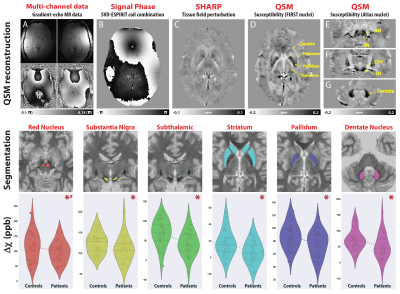 |
16 |
 Iron-related gene expression associated with magnetic susceptibility reductions: Application to the pathophysiology of a movement disorder population Iron-related gene expression associated with magnetic susceptibility reductions: Application to the pathophysiology of a movement disorder population
Ahmad Kanaan, Alfred Anwander, Riccardo Metere, Andreas Schäfer, Torsten Schlumm, Jamie Near, Berkin Bilgic, Kirsten Müller-Vahl, Harald Möller
We employ a genetic-imaging approach to examine the underlying genetic basis of magnetic susceptibility reductions at a major locus of pathophysiology in Gilles de la Tourette syndrome (GTS). Voxel-wise statistical differences of motor-striatal susceptibility exhibited significant associations with the expression profile of iron-related gene-sets extracted from the Allen Human Brain Atlas, thus suggesting that the expression of iron-related genes coincides with patterns of susceptibility reductions in GTS. This work supports previous studies relating magnetic susceptibility to brain iron and provides an example of an analytic strategy in which valuable insights can be gleaned by exploring associations between gene-expression and image-derived phenotypes.
|
 |
0223.
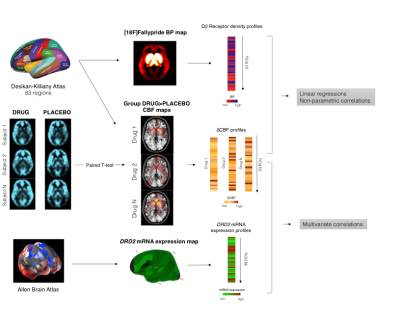 |
17 |
 Multimodal ASL/PET/mRNA-expression analysis reveals CBF changes after single dose of antipsychotics depend on dopamine D2 receptor density profiles. Multimodal ASL/PET/mRNA-expression analysis reveals CBF changes after single dose of antipsychotics depend on dopamine D2 receptor density profiles.
Pierluigi Selvaggi, Mattia Veronese, Peter Hawkins, Ottavia Dipasquale, Gaia Rizzo, Juergen Dukart, Fabio Sambataro, Alessandro Bertolino, Steven Williams, Federico Turkheimer, Mitul Mehta
In this study, we tested whether CBF changes after acute administration of antipsychotics in healthy volunteers are associated with receptor distribution profiles of one of their main targets, namely the dopamine D2 receptor. Receptor distribution profiles were extracted from an in-house [18F]Fallypride template and from the Human Allen Brain Atlas. Results show that changes in CBF measures are directly proportional to dopamine D2 receptor levels as indexed by PET maps and mRNA expression levels. Overall the present study shows evidence that CBF is ultimately a functional marker which can be adopted in drug challenges to inform the drug development process.
|
|
0224.
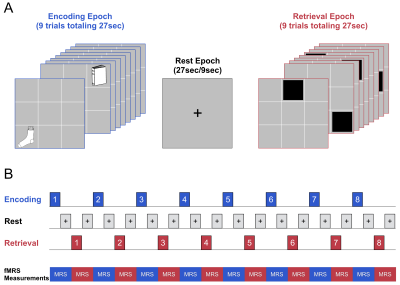 |
18 |
 Impaired modulation of hippocampal glutamate during memory consolidation in schizophrenia: Evidence from ¹H fMRS Impaired modulation of hippocampal glutamate during memory consolidation in schizophrenia: Evidence from ¹H fMRS
Jeffrey Stanley, Patricia Thomas, Dalal Khatib, Asadur Chowdury, Usha Rajan, Luay Haddad, Amirsadri Alireza, Vaibhav Diwadkar
Schizophrenia is one of the most debilitating, life-long mental illnesses where treatment has a limited impact in restoring real-life functions such as deficits in learning and memory. The hippocampus is particularly rich in glutamatergic neurons and altered neuroplasticity related to glutamate has been proposed as a critical mechanism mediating learning and memory in schizophrenia. Understanding glutamate-related dysfunction in schizophrenia may therefore, elucidate mechanisms underlying the illness as well as help tailor intervention strategies. Here we provide the first ever evidence of a dysfunctional modulation of hippocampal glutamate during memory encoding in schizophrenia using ¹H fMRS.
|
 |
0225.
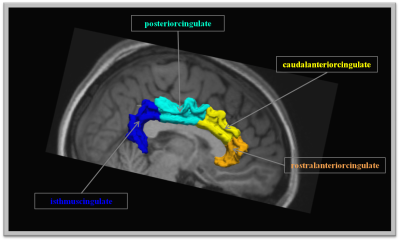 |
19 |
 N-acetyl-cysteine supplementation improves functional connectivity in the cingulate cortex in early psychosis N-acetyl-cysteine supplementation improves functional connectivity in the cingulate cortex in early psychosis
Emeline Mullier, Timo Roine, Alessandra Griffa, Philipp Baumann, Philippe Conus, Kim Do, Patric Hagmann
Schizophrenia implies different alterations in prefrontal cortex and in particular, a disrupted connectivity in this brain area and a redox dysregulation. In a previous analysis, glutathione levels (main antioxidant and redox regulator) correlated with functional connectivity within the cingulate cortex. In this study, we investigate the effect of N-acetyl-cysteine (NAC) (precursor of glutathione) supplementation on functional connectivity in early psychosis patients. The results show an increased functional connectivity strength and betweenness centrality in these regions, suggesting that cingulate cortex functional connectivity could be a biomarker for NAC treatment efficacy
|
 |
0226.
 |
20 |
 Altered Brain Development in Infants and Young Children with at Risk Genetics for Psychiatric Dysfunction Altered Brain Development in Infants and Young Children with at Risk Genetics for Psychiatric Dysfunction
Justin Remer, Douglas Dean III, Muriel Bruchhage, Sean Deoni
Catechol-O-methyltransferase (COMT) polymorphisms have been implicated as an important contributor to psychosis and cognitive differences. Such cognitive alterations may have a neurodevelopmental basis, however, the effect of COMT polymorphisms on early brain development are unclear. Here, we perform the first longitudinal study of differential cortical maturation in infants and young children ages 1 to 6 based on COMT genotype. We demonstrate altered rates of cortical development in the cingulate, frontal and temporal lobes in children with the rs46480 (Val/Met) genotype, suggesting the COMT genotype has an important impact on brain maturation.
|
 |
0227.
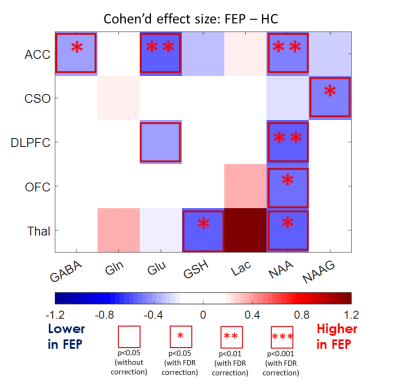 |
21 |
7T MRS in First Episode Psychosis: Neurotransmitter Deficits and Neuronal Impairment
Video Permission Withheld
Anna Min Wang, Subechhya Pradhan, Akira Sawa, Peter Barker
The results of a 7T MRS study of a large cohort of patients with a first episode of psychosis (FEP) and healthy control subjects (HC) are reported. In patients with FEP, significant reductions in the neurotransmitters glutamate and GABA were found in selected gray matter regions, and the neuromodulator NAAG was reduced in white matter. Other metabolic abnormalities were reduced NAA (suggesting neuroaxonal damage) and glutathione. Metabolite differences were also found to depend on diagnosis. This study suggests that 7T MRS is a useful modality for understanding the molecular pathophysiology of psychosis.
|
|
0228.
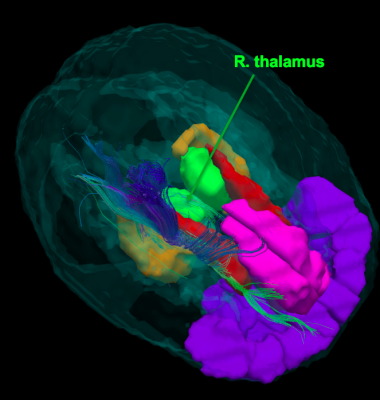 |
22 |
 A DTI connectome and machine learning approach to predict symptom improvement in depressed adolescents with cognitive-behavioral therapy (CBT) A DTI connectome and machine learning approach to predict symptom improvement in depressed adolescents with cognitive-behavioral therapy (CBT)
Olga Tymofiyeva, Justin Yuan, Colm Connolly, Eva Henje Blom, Duan Xu, Tony Yang
We applied machine learning to DTI-based structural connectome data in order to predict improvement of symptoms in 30 depressed adolescents with cognitive-behavioral therapy (CBT). The J48 pruned tree classifier was applied with a 10-fold cross-validation, resulting in an 83% accuracy. The resulting tree highlights the role of the thalamus, a region known to be directly involved in anticipatory anhedonia and generation of goal-directed behavior, the lack of which can make subsequent CBT ineffective. The gained knowledge can significantly improve treatment planning in cases of adolescent depression and help optimize and develop new preventive and therapeutic interventions for this devastating disorder.
|
|
0229.
 |
23 |
 Neural network classification of ADHD based on white matter connectograms derived from diffusion spectrum imaging Neural network classification of ADHD based on white matter connectograms derived from diffusion spectrum imaging
Chang-Le Chen, Yung-Chin Hsu, Susan Gau, Wen-Yih Tseng
The diagnosis of ADHD relies on psychiatrists’ knowledge and subjective experience. Many studies aimed to develop an objective method to assist diagnosis, but the performance of classification between ADHD and controls was not acceptable for clinical use. Here, we proposed a neural network model based on white matter information to classify ADHD and typically developing controls. Diffusion spectrum imaging and tract-based automatic analysis were used to measure properties of white matter. The neural network classification model was developed with high accuracy in the training and test data. It might be helpful to provide an objective way for diagnosis of ADHD.
|
|
0230.
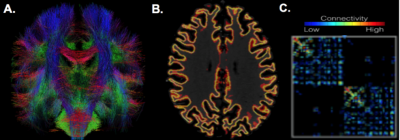 |
24 |
 Hippocampal-subfield Specific Connectivity Alterations in Major Depressive Disorder Patients at 7 Tesla Hippocampal-subfield Specific Connectivity Alterations in Major Depressive Disorder Patients at 7 Tesla
John Rutland, Prantik Kundu , Patrick Hof, James Murrough, Priti Balchandani
This study quantifies connectomic changes that occur within hippocampal subfields in patients with major depressive disorder (MDD). Using ultra-high field MRI (7 Tesla), we performed subfield-specific tractography in 6 MDD patients and 9 healthy controls. The degree of the hippocampal fissure was bilaterally increased in MDD patients compared to controls. Edgewise analyses revealed that CA3-vPFC, CA3-dlPFC, and CA1-vPFC edges were significantly increased in MDD patients compared to controls within the right hemisphere. These in vivo findings indicate that MDD patients display increased connectivity within certain hippocampal subfields, and between subfields the prefrontal cortex (PFC).
|
|
0231.
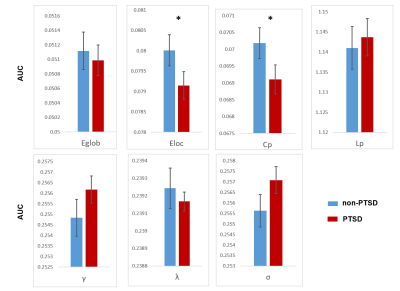 |
25 |
 Reduced Local Segregation in Single-Subject Grey Matter Networks in Adult PTSD Reduced Local Segregation in Single-Subject Grey Matter Networks in Adult PTSD
Running Niu, Du Lei, Qiyong Gong
The present study investigated graph properties of single-subject grey matter networks in PTSD using a new method proposed by Tijms and colleagues to statistically describe gray matter networks in individual subjects using T1-weighted MRI scans. Compared with trauma exposed controls, global topology of single-subject grey matter networks of PTSD was characterized by decreased clustering coefficient and local efficiency. The reduced segregation in grey matter network and its negative relation with increased segregation in the functional network may be important for understanding the nature of the brain network disorganization associated with PTSD and facilitate clinical diagnosis in patients with suspected PTSD
|
|
0232.
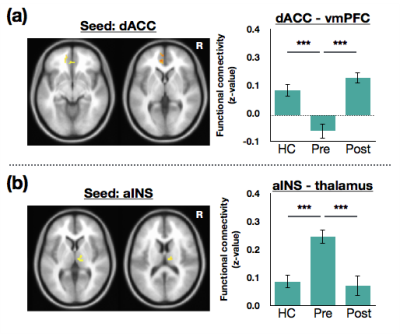 |
26 |
 Sertraline treatment modulates salience connectivity in major depressive disorder Sertraline treatment modulates salience connectivity in major depressive disorder
Li-Ming Hsu, Changwei Wu, Chien-Yuan Lin, Chi-Yun Liu, Timothy Lane, Ching-Po Lin, Chi-Bin Yeh, Hung-Wen Kao
How sertraline alleviates depressive syndrome by modulating the intrinsic connectivity networks (ICNs) remains elusive. Herein, we take a network-based investigation on SN to rationalize the functional and behavior effect of the sertraline treatment using resting-state functional connectivity (rsFC). Our study demonstrated that the sertraline treatment exhibited beneficial modulations on the DNMTL–SN–thalamus pathway for alleviating depressive syndromes in MDD patients.
|
|
0234.
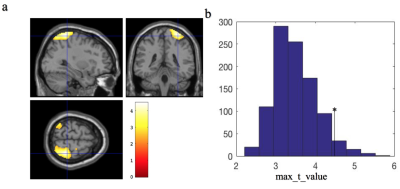 |
28 |
 Abnormal Perfusion and Perfusion fluctuation in Bipolar Disorder measured by ASL Abnormal Perfusion and Perfusion fluctuation in Bipolar Disorder measured by ASL
Weiying Dai, Mingzhao Chen, Li Zhao, Nicolas Bolo, David Alsop, Keshavan Matcheri
We aim to investigate whether dynamic perfusion image time series instead of static perfusion image can offer extra insight to bipolar disorder (BD). Average perfusion and perfusion fluctuation maps were compared between patients with BD and controls using customized Statistical non-Parametric Mapping (SnPM). Perfusion decrease in the posterior lateral regions of the default mode network and increase of perfusion fluctuations in the parahippocampus and amygdala regions were observed. The abnormal perfusion fluctuations may be supported by perturbed functional connectivity at the same regions. These results indicate that dynamic perfusion image series may serve as potential novel neuroimaging biomarkers for BD.
|
|
0235.
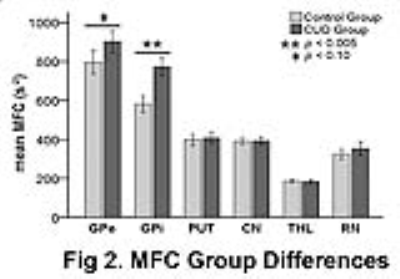 |
29 |
 Elevated brain iron in cocaine addiction as indexed by magnetic field correlation imaging Elevated brain iron in cocaine addiction as indexed by magnetic field correlation imaging
Vitria Adisetiyo, Corinne McGill, William DeVries, Jens Jensen, Colleen Hanlon, Joseph Helpern
Brain iron is critical for neural processes implicated in addiction. Recently, disrupted iron regulation was detected in individuals with cocaine use disorder (CUD) using quantitative susceptibility mapping. Our goal was to replicate these findings using an alternative iron imaging method called magnetic field correlation imaging. Consistent with the only study of brain iron in CUD, we detected elevated brain iron levels in globus pallidus regions and loss of age-related iron accumulation in CUD. Our replication of aberrant brain iron findings in CUD using a different MRI modality lends support for further investigation of iron homeostasis in CUD.
|
|
0236.
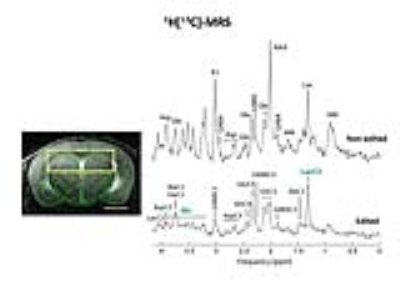 |
30 |
 Deletion of CRTC1 is associated with strong neuroenergetic dysfunctions in a mouse model of mood disorders. Deletion of CRTC1 is associated with strong neuroenergetic dysfunctions in a mouse model of mood disorders.
Antoine Cherix, Guillaume Donati, Blanca Lizarbe, Hongxia Lei, Carole Poitry-Yamate, Jean-René Cardinaux, Rolf Gruetter
This project pursues a previous study presented at ISMRM1 which established an age- and brain region dependent neurochemical metabolic profile in a Crtc1-/- based mouse model of mood disorders. Here, we show that a decline in cerrebral lactate levels is a consistent and reliable endophenotype2 of Crtc1 deletion, and an indicator of neuroenergetic dysfunction in the dorsal hippocampus. The decline in brain lactate levels appears to arise from a measured reduction of glucose entering the brain.
|
|

 Watch the full Pitch Session Here
Watch the full Pitch Session Here













